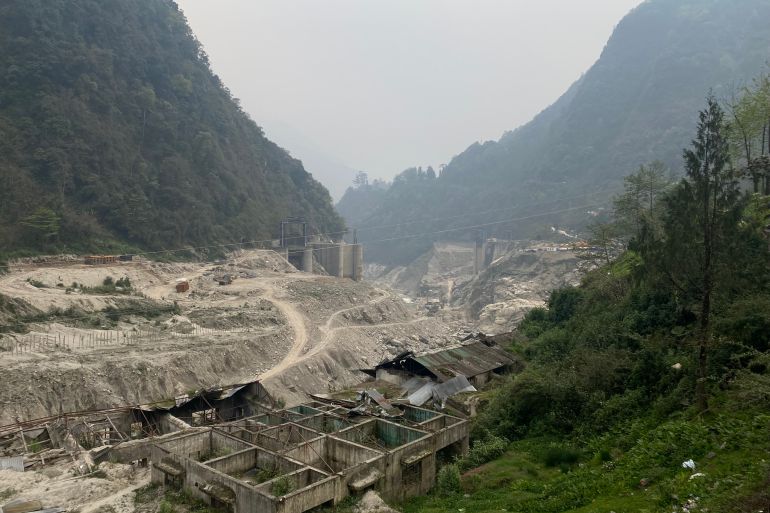In the majestic yet precarious Himalayan region, a dire humanitarian and ecological crisis continues to unfold, nearly two years after a catastrophic glacial lake outburst flood obliterated the Teesta III dam in Sikkim. This disaster, which displaced thousands and devastated vast swathes of land, is now compounded by contentious plans to rebuild the dam, igniting profound fears among the Indigenous Lepcha communities who call this seismically active and ecologically fragile landscape home.
The harrowing night of October 4, 2023, saw a massive glacial lake outburst flood (GLOF) triggered by a sudden avalanche into South Lhonak Lake, unleashing over 50 million cubic metres of water. This colossal surge overwhelmed the 1,200-megawatt Teesta III dam, Sikkim’s largest hydropower plant, releasing an additional five million cubic metres from its reservoir. Residents like Tashi Choden Lepcha experienced terrifying tremors and a tsunami-like wave, escaping their homes in the dark amid the heavy rain.
The high-velocity flood cascaded through the Teesta River valley, carrying an estimated 270 million cubic metres of sediment and debris. The widespread devastation stretched across Sikkim, parts of West Bengal, and Bangladesh, claiming at least 55 lives, leaving 74 missing, and displacing over 7,025 people. Critical infrastructure suffered immense damage, with nearly 26,000 buildings affected, 31 bridges destroyed, vast farmlands inundated, and key highways compromised.
Both the Teesta III and Teesta V dams have remained non-operational since the flood, with repair work ongoing. Scientists describe the event as one of the most devastating flooding disasters recorded in the Himalayas in recent decades, underscoring the region’s extreme vulnerability to climate-induced hazards and the imperative for sustainable infrastructure development, particularly following the Sikkim disaster.
Despite the fresh memory of the catastrophe and ongoing environmental concerns, the Ministry of Environment, Forest and Climate Change has controversially approved plans to reconstruct the Teesta III dam. This decision has been made without any public consultation, intensifying anxieties among local communities, particularly given the increased water levels from the ongoing monsoon season, which have already triggered new landslides and isolated remote areas of North Sikkim, hindering recovery efforts.
The Indigenous Lepcha communities, known for their deep spiritual connection to the rivers and mountains, are vehemently protesting the rebuilding. Groups like Affected Citizens of Teesta (ACT), who previously halted several hydropower projects, emphasize the region’s fragile soil and the increased risk of landslides if tunnels are dug under their villages. Their pleas highlight a critical issue of environmental justice and the protection of ancestral lands against large-scale, potentially hazardous projects.
Further exacerbating these concerns are plans to rebuild the dam to an alarming height of 118.64 metres, double its original size. Opposition leaders warn that such a structure, coupled with escalating climate change impact and the continued expansion of hazardous glacial lakes like South Lhonak, could lead to far more extensive submergence and devastation downstream, impacting settlements across multiple Indian states. Displaced families currently languish in makeshift relief camps, facing difficult conditions and limited access to basic amenities.
Experts, including cryosphere specialists, stress the absolute necessity of a detailed risk assessment considering future climate scenarios before any reconstruction proceeds. Community members like Leboon Thapa, whose football dreams were shattered by the Himalayan flood, and Tikaram Karki, who lost his home and business, echo these sentiments, demanding stronger protection walls and acknowledgement of how past planning failures and unchecked silt buildup worsened the dam collapse. Their voices underscore the immediate need for effective rehabilitation and safety measures.
As nearly two years pass, families like Tashi Choden Lepcha’s remain without permanent homes, their future uncertain. Discussions around relocating displaced families to safer, higher ground offer a glimmer of hope, yet the process is slow and arduous. The continued pursuit of large-scale infrastructure projects without adequate safeguards or community involvement raises fundamental questions about development priorities in a region increasingly on the front lines of climate change and its devastating consequences, pushing these vulnerable communities to the brink.






Leave a Reply